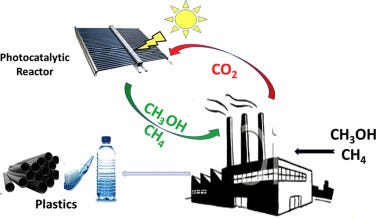Learning This Week: Artificial Photosynthesis
Every week I learn something interesting about a topic.
If you have not signed up for the free newsletter yet, consider doing so now at https://intelsense.substack.com
There is an emerging method of producing eFuel that mimics the process of photosynthesis. This technology is called artificial photosynthesis, and it aims to directly convert sunlight, water, and carbon dioxide (CO₂) into usable fuels, much like how plants convert sunlight, water, and CO₂ into glucose (energy) and oxygen.
How Artificial Photosynthesis Works:
In natural photosynthesis, plants use chlorophyll to absorb sunlight and catalyze a series of reactions that split water into hydrogen and oxygen while fixing carbon dioxide into organic molecules. Similarly, in artificial photosynthesis, scientists develop materials that can capture sunlight and drive chemical reactions to split water into hydrogen and oxygen while using the carbon dioxide to form hydrocarbon fuels or other chemical products.
The key components of artificial photosynthesis are:
Photocatalysts: Materials that absorb sunlight and use the energy to drive chemical reactions.
Electrochemical Reactions: Processes that split water (H₂O) into hydrogen (H₂) and oxygen (O₂) using solar energy.
Carbon Fixation: Capturing CO₂ and combining it with hydrogen to produce hydrocarbons, which can be used as fuel.
Types of Artificial Photosynthesis Systems:
Photoelectrochemical Cells (PECs): These systems are similar to solar panels, but instead of generating electricity, they directly drive chemical reactions to produce fuel. The PECs use sunlight to split water into hydrogen, which can be further combined with CO₂ to create eFuel.
Photocatalytic Systems: These systems use light-absorbing catalysts (usually made of semiconductors) that can trigger the necessary reactions to break down water molecules and capture CO₂.
Advantages of Artificial Photosynthesis:
Direct Solar-to-Fuel Conversion: Unlike traditional eFuel production, which first generates electricity and then uses it to produce fuel, artificial photosynthesis can directly convert sunlight into fuel in one step, potentially improving efficiency.
Sustainable and Renewable: Since it mimics natural processes and uses abundant resources like sunlight, water, and CO₂, artificial photosynthesis could provide a long-term sustainable energy solution.
Carbon Neutral or Negative: Like eFuels, the CO₂ used to create the fuel is captured from the atmosphere, making the process carbon neutral. In some cases, it could even be carbon negative if it captures more CO₂ than is emitted.
Challenges:
Efficiency: While natural photosynthesis is highly efficient for plants, the efficiency of artificial systems in converting sunlight into usable fuel is currently quite low. Improving this efficiency is a key area of research.
Scalability: Producing artificial photosynthesis systems at a scale large enough to replace fossil fuels is another challenge. Many of the materials and technologies are still in the experimental stage.
Cost: Developing cost-effective catalysts and systems is essential for making artificial photosynthesis commercially viable.
Current Progress:
Several research groups around the world are working on developing artificial photosynthesis technologies. For example:
Joint Center for Artificial Photosynthesis (JCAP): A U.S. research initiative focused on advancing solar-fuel technologies.
HyperSolar: A company working on developing systems that use sunlight to split water and produce hydrogen fuel.
Photosynthetic Biohybrid Systems: Some researchers are even integrating biological systems (like bacteria) with artificial systems to enhance efficiency and mimic natural photosynthesis more closely.
In summary, artificial photosynthesis is a promising technology that replicates the natural process of photosynthesis to produce renewable eFuels from sunlight, water, and CO₂. While still in the research and development phase, it offers the potential for a highly sustainable and direct solar-to-fuel conversion process in the future.
DISCLAIMER:
Investments in the securities market are subject to market risks. Read all the related documents carefully before investing.
SEBI Registered Research Analyst - Cupressus Enterprises Pvt Ltd - INH000013828.
Registration granted by SEBI and certification from NISM in no way guarantee the performance of the intermediary or provide any assurance of returns to investors.




